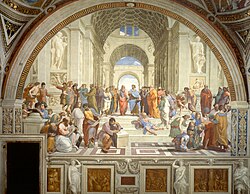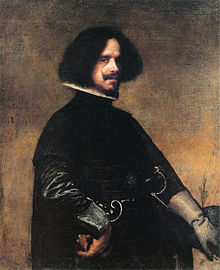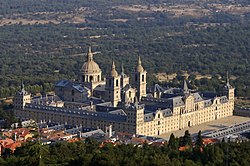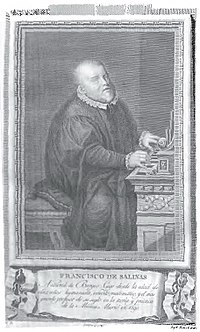
The Spanish Golden Age was a period of flourishing in arts and literature in Spain, coinciding with the political rise of the Spanish Empire under the Catholic Monarchs of Spain and the Spanish Habsburgs. The greatest patron of Spanish art and culture during this period was King Philip II (1556–1598). His royal palace, El Escorial, invited the attention of some of Europe's greatest architects and painters, such as El Greco, who infused Spanish art with foreign styles and helped create a uniquely Spanish style of painting. The period is associated with the reigns of Isabella I, Ferdinand II, Charles V, Philip II, Philip III, and Philip IV, when Spain was at the peak of its power and influence in Europe and the world.

Spanish art has been an important contributor to Western art and Spain has produced many famous and influential artists including Velázquez, Goya and Picasso. Spanish art was particularly influenced by France and Italy during the Baroque and Neoclassical periods, but Spanish art has often had very distinctive characteristics, partly explained by the Moorish heritage in Spain, and through the political and cultural climate in Spain during the Counter-Reformation and the subsequent eclipse of Spanish power under the Bourbon dynasty.

Sigüenza is a city in the Serranía de Guadalajara comarca, Province of Guadalajara, Castile-La Mancha, Spain.

Spanish Renaissance architecture was that style of Renaissance architecture in the last decades of the 15th century. Renaissance evolved firstly in Florence and then Rome and other parts of the Italian Peninsula as the result of Renaissance humanism and a revived interest in Classical architecture. In Spain, the Renaissance began to be grafted to Gothic forms as mathematicians and engineers rediscovered building as one of the technological sciences. In the time of King Felipe II (1556–1589), the Renaissance influence expanded throughout the territory thanks to the dissemination of architectural treatises.
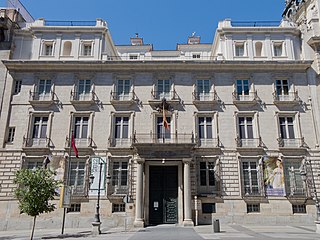
The Real Academia de Bellas Artes de San Fernando, located on the Calle de Alcalá in the centre of Madrid, currently functions as a museum and gallery. A public law corporation, it is integrated together with other Spanish royal academies in the Instituto de España.

The National Museum of Sculpture is a museum in Valladolid, Spain, belonging to the Spanish Ministry of Culture. The museum has an extensive sculptural collection ranging from the Middle Ages to the 19th century. The collections come mostly from churches and monasteries in the Region of Castile, whose pieces of religious art were confiscated by the State in 1836, by order of Minister of Finance Mendizábal. Other parts of the collections come from particular donations, deposits or acquisitions by the State.

The Granadan school of sculpture or Granadine school of sculpture—the tradition of Christian religious sculpture in Granada, Andalusia, Spain—began in the 16th century and constituted a clear tradition of its own by the 17th century. The extraordinary artistic activity of Renaissance Granada brought artists to that city from various regions of Spain and from other parts of Europe.

Felipe Bigarny, also known as Felipe Vigarny, Felipe Biguerny or Felipe de Borgoña, etc. and sometimes referred to as El Borgoñón, was a sculptor born in Burgundy (France) but who made his career in Spain and was one of the leading sculptors of the Spanish Renaissance. He was also an architect.

Purism is an initial phase of Renaissance architecture in Spain, which took place between 1530 and 1560, after Isabelline Gothic and prior to the Herrerian architecture in the last third of the 16th century. The name "Prince Philip" refers to the period in which Philip II of Spain had not yet received the inheritance of the Spanish Monarchy by abdication of his father, the Emperor Charles V (1556). The name "Serlian" is due to the influential architect and treatise Sebastiano Serlio.
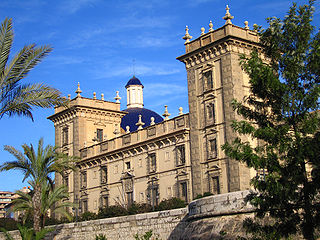
The Museu de Belles Arts de València is an art gallery in Valencia, Spain, founded in 1913. It houses some 2,000 works, most dating from the 14th–17th centuries, including a Self portrait of Diego Velázquez, a St. John the Baptist by El Greco, Goya's Playing Children, Gonzalo Pérez's Altarpiece of Sts. Ursula, Martin and Antony and a Madonna with Writing Child and Bishop by the Italian Renaissance master Pinturicchio. It houses a large series of engravings by Giovan Battista Piranesi.
The Parnaso Español: colección de poesías escogidas de los más célebres poetas castellanos, or simply Parnaso Español, is an anthology edited by Juan José López de Sedano. It was published in nine volumes, between 1768 and 1778. The first five volumes were printed by Joaquín Ibarra by request of Antonio de Sancha, who printed the remaining volumes in his newly inaugurated press.

The Hospital de Tavera, also known as the Hospital de San Juan Bautista, Hospital de afuera, or simply as Hospital Tavera, is an important building of Renaissance architecture located is in the Spanish city of Toledo. It was built between 1541 and 1603 by order of the Cardinal Tavera. This hospital is dedicated to John the Baptist and also served as pantheon for its patron, Cardinal Tavera. Initially it began to be constructed under the supervision of Alonso de Covarrubias, being succeeded by other architects, with Bartolomé Bustamante finishing the work.
